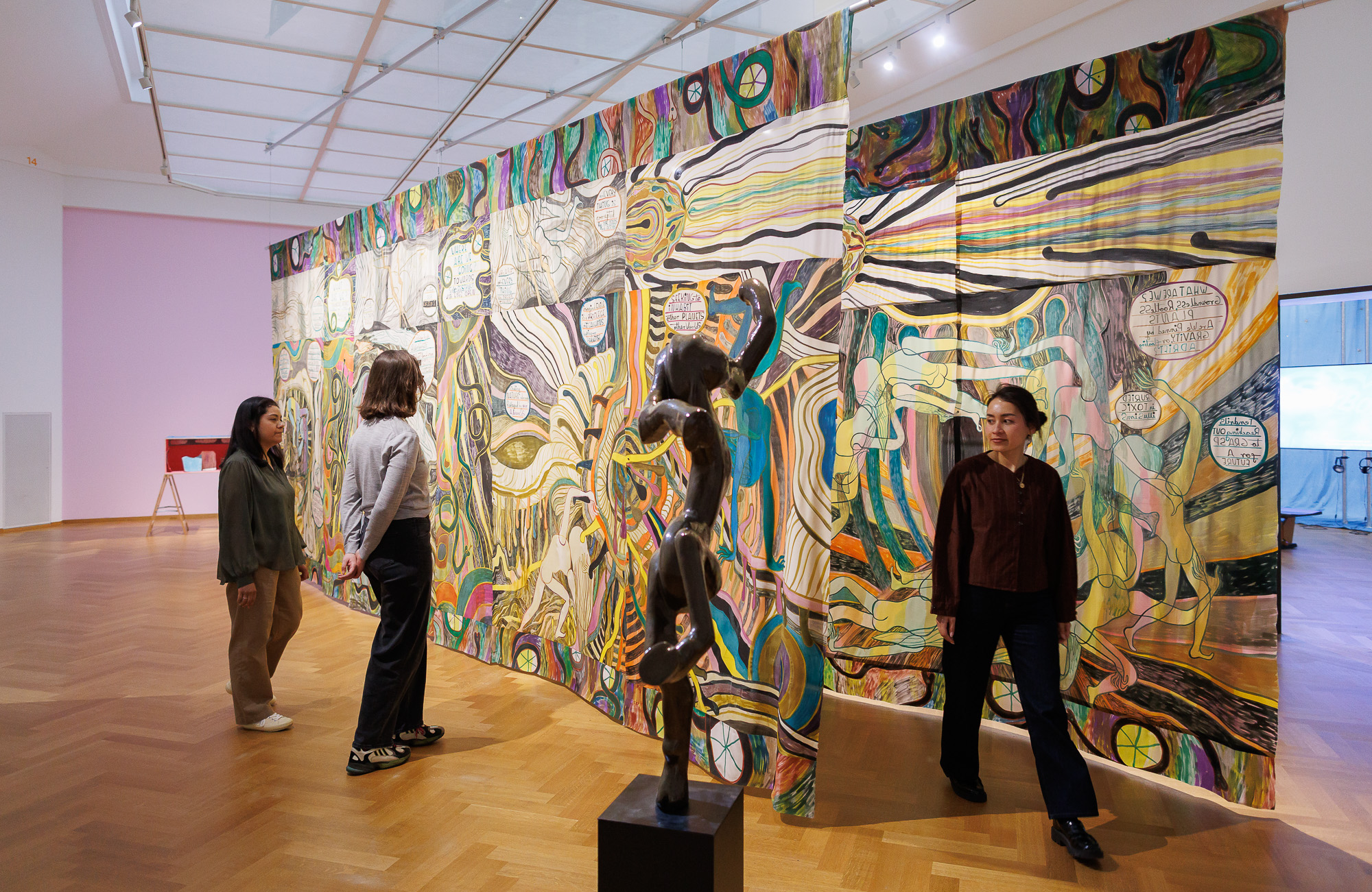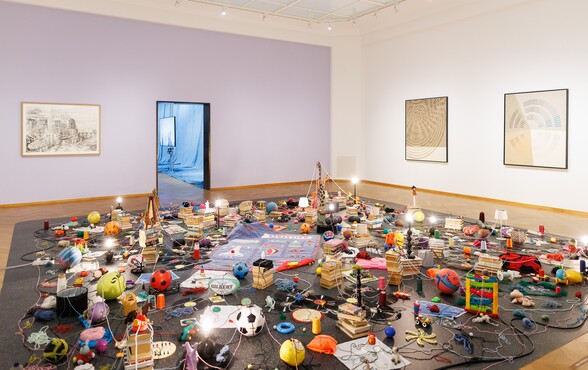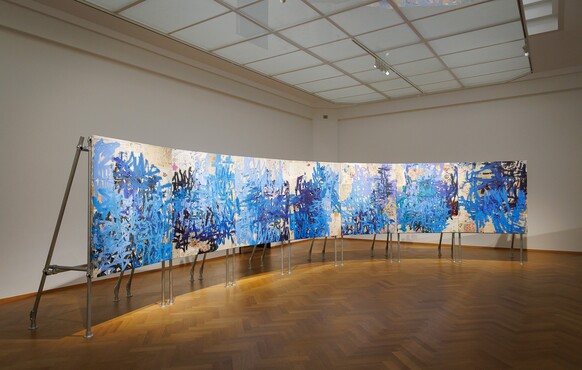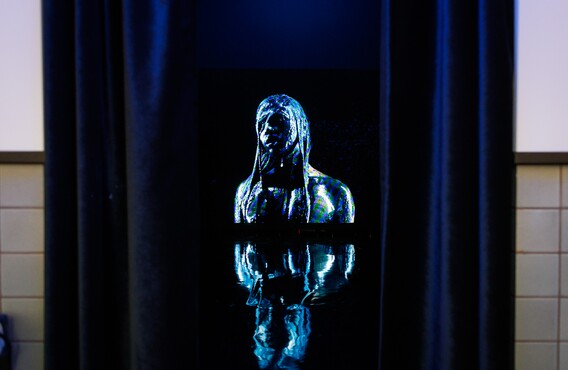Ontdek de collectie
Kunstmuseum Den Haag has a treasure chamber of over 160.000 pieces of art. Here we work on making the highlights from this collection available online.
The triangle of art, science and society as a way to a just future
Essay by Judi Mesman
Longread, reading time approx. 10 minutes
I know the world is bruised and bleeding, and though it is important not to ignore its pain, it is also critical to refuse to succumb to its malevolence. Like failure, chaos contains information that can lead to knowledge - even wisdom. Like art. - Toni Morrison
The bruised and bleeding world that Toni Morrison writes about in the quote above is new and old at the same time. For some who have experienced decades of relative prosperity and tranquility this reality is a shocking discovery, for others from less privileged parts of the world it is a matter of course. More than a third of the world's population lives under an authoritarian regime and another fifteen percent have to deal with democracies with authoritarian traits in which civil rights and freedoms are not guaranteed. The authoritarian populism that is on the rise in Europe is characterized by us-versus-them thinking in which the national culture is supposedly threatened by the 'other' and the masses oppose 'the elite'. As many protest signs at the demonstration against racism and fascism of March 22, 2025 in Amsterdam read: 'The future is now!' Consciousness in the present creates the reality of tomorrow. Or citing James Baldwin: 'There is never time in the future in which we will work out our salvation. The challenge is in the moment; the time is always now.' This urgency is at the heart of the New New Babylon exhibition.
History shows that art and science (together with independent judicial courts and freedom of the press) are often the first to suffer under authoritarian and/or populist leaders. Art and science are ideal targets because they are not only associated with the elite, but also stand for hope and new ideas that go against the prevailing norms, for questioning what seems self-evident, and for viewing society from new perspectives. Both areas are essentially about imagination, about creativity and experimentation in as yet unknown territory, which creates new insights, visions of a more beautiful and better world, and sometimes even the revolution. Seen in this way, the two professions should be natural allies in the pursuit of a just society. Yet the promising 'triangle' of art, science and society is far from self-evident.
As I thought about the barriers to collaboration between art and science, the draw-a-scientist test came to mind. For decades, research has been done into the image that people have of scientists by asking them to draw a scientist. And for decades that has come down to an older white man in a white coat. A simple google search with the term 'scientist' leads to images that show exactly that image, usually in a sterile colorless laboratory environment with all kinds of complicated instruments. The stereotypical image of an artist is more or less diametrically opposed to this. Although research into this image is lacking to my knowledge, google comes up with images of mainly white men (but also women) of different ages in messy studios with colorful paintings where the artist's clothing is often also covered in paint. With these images, it is no wonder that art and science are not seen as natural partners.
But you don't have to be a surrealist to understand that images are deceptive and should not be confused with reality. In science and the arts, a variety of disciplines can be distinguished, while the stereotypes are based on the natural sciences and painting. You will not easily find a historian (alpha) or sociologist (gamma) who are usually engaged with societal themes in a white coat in a laboratory, but they also have a lower prestige than beta scientists. For example, a prominent mathematician once claimed on television that beta scientists are of course the smartest. He said he knew a few alpha scientists who could do great things, but he had never met a gamma scientist who could do something worth doing. I'm afraid he didn't mean it ironically. The program maker had indeed done his best to proudly uphold the stereotype of the socially inept unworldly scientist.

Alleged unworldliness is attributed to both scientists and artists. Locked up in a lab or studio, in deep concentration and monomaniacally on the hunt for a scientific or creative breakthrough. Some degree of madness as an inevitable side effect of genius also fits that image. But at first glance, these do not seem to be the types that are likely to spark or sustain the revolution. On the other hand, in a world where utility and profit dictate whether something has value, science for the sake of science and art for art's sake are radical in and of themselves. Knowledge and beauty as intrinsically valuable for humanity, for being human, even if it does not directly yield something tangible or communicate a concrete message. This idea can actually be considered subversive in this neoliberal reality, especially in the eyes of politicians who deeply distrust intellect and creativity. ‘Left-wing hobbies’ on which the hard-working Dutch person does not want to spend their tax money.
These left-wing hobbies are seen as even more problematic if scientists and artists do get involved in society and the future of humankind and the planet. Knowledge for knowledge's sake can still count on some admiring approval despite the suspicious scent of intellectualism, because scientists are expected to be neutral and to produce value-free knowledge. I will omit a treatise on the impossibility of neutrality (but see, for example, the work of Sandra Harding), because more interesting in this discussion is the undesirability of neutrality. Should a scientist who researches child abuse really be indifferent to that phenomenon? In response to this example, people quickly shake their heads no. But if you ask whether a scientist who researches racism can have an opinion about it, the 'accusation' of activism is never far away. Of course, a scientist must adhere to academic standards for research so that the results are verifiable, valid and reliable, but that certainly does not have to stand in the way of a strong political-social opinion. In fact, as Joseph-Salisbury and Connely write in their book Anti-racist scholar-activism when they summarize an observation by W.E.B. Dubois: 'There is simply too much at stake to engage in pretensions of neutrality'.
In the arts, too, the discussion about social engagement flares up from time to time, but there are infinitely more initiatives by artists who work with local communities for social justice than such initiatives by scientists. In the book Radical Futurisms by T.J. Demos, the arts are directly linked to anti-system activism and radical futurism: 'radical futurisms resituate and expand time's operation as contestable, reinventable, and multiply structured'. The book describes many inspiring examples from all over the world in which artists are committed to oppression, solidarity and justice with their work. The work of Dutch artists such as Jonas Staal and Jeanne van Heeswijk is also discussed as exemplary of collective creativity for the benefit of radical aesthetic-political visions of the future. As Staal said in an interview, this is not always easy, because 'there is always a struggle between the world that is there and a world that you want to make.' Scientists often limit themselves to thinking about knowledge they want to create, which others can then use to make a better world.
Should all artists and scientists then commit themselves in their work to activism with a political goal for the future? Certainly not. In both art and science, freedom and autonomy must be paramount. As long as people do not claim to produce value-free art or science, you won't hear me complaining. Although, maybe you will. People who work in areas that should function as bastions of freedom also have a duty to staunchly defend freedom in a more general sense. If not out of solidarity, then at least out of self-preservation. The now often heard "silence is complicity" is actually derived from a statement by Einstein, pretty much the prototype of a scientist. So even if the content of the work does not directly serve social purposes, silence is not a responsible option. As one of my children who moves in the world of the performing arts recently said: 'I don't care if artists use their work for a better world, as long as they take action against injustice as human beings'. At the same time, the distinction between being human and being an artist or scientist is usually very murky. Whichever way you look at it, the socially engaged person working in the arts or science should at the very least feel free to take a stand professionally and to use their talent for future-oriented and progressive work for the benefit of society.
In addition to stereotypes and internal struggles about the role that art and science should or should be allowed to play in shaping society now and in the future, there are also institutional obstacles. Scientists practice their profession almost exclusively in the context of an institute, usually a university. Artists, on the other hand, rarely work in an institutional context and do not fit into the rigid job description system of Dutch universities. The funding of the two sectors also takes place in completely separate domains, with only a few exceptions in the form of one-off calls for multidisciplinary projects that connect science and art. Most collaborations therefore have to rely on motivated individuals who look for each other across domain boundaries out of intrinsic interest. But without funding and institutional embedding, long-term connections that can really work in a future-oriented way are much more difficult to achieve.
There are also institutional bright spots. For example, in 2014, the Royal Netherlands Academy of Arts and Sciences (KNAW) decided to establish the Society of Arts (AvK). This was actually a return to the origins of the KNAW, whose predecessor already had a department for fine arts in the first half of the 19th century. In its mission, the AvK clearly describes its purpose and also mentions (albeit implicitly) the value of the triangle of art, science and society: 'The Society of Arts consolidates and champions the position of art in our society. It does so because art is indispensable for the welfare of society and offers valuable ways to better understand and examine the world. Its approach is twofold: it represents the interests of the art world and it addresses the major challenges of our time. In that approach, the Society consistently emphasizes the relationship between the various artistic disciplines, between the arts and society, and between the arts and the sciences.'
This year, five new members of the AvK have been inaugurated: a musician, a theater maker, a writer, two visual artists. Just like every year, it was an inspiring company that was introduced to the public during a festive gathering with beautiful odes and musical intermezzos in the Trippenhuis in Amsterdam, or 'the house' of the KNAW as President Marileen Dogterom always calls it. The event was mainly attended by family and friends of the new members and 'older' members of the AvK. However, only a handful of scientists were present, while the KNAW has 500 members and any interested scientist is free to attend the meeting. Art and science are therefore not that easy to integrate.
In her opening speech, President of the AvK Liesbeth Bik once again explained why the triangle of art, science and society is so valuable: 'The loss of freedom, contempt for lives and the loss of academic and artistic freedom are interrelated. They are at stake in our world disorder. (...) I see the role of the arts (...) as an activity to turn existing knowledge against itself in order to imagine possible and impossible visions of the future.' With this perspective, she sees an important place for collaboration with other fields of knowledge such as science to understand reality and shape society. The step towards a future-oriented agenda for a better world can be found in various initiatives of both the KNAW and the AvK, but truly integrative programmes across domain boundaries are still rare.
All things considered, the promising triangle of art, science and society is often still a loose collection of three lines that still have to be glued together so that they really form a triangle. It is tempting to immediately think about that glue in terms of institutions and funding. Of course, institutional and financial support can give wings to an idea or a movement, but a radical rethinking of the future is rarely achieved with desks and money, so I’m told. There some truth in that, although we should not undervalue those desks and that money. They can also offer the peace and security that make room for the meaningful work that is otherwise only feasible in the evening hours, always has to run on volunteers, and always struggles with a lack of suitable workplaces and materials. For some such scarcity may signify the dream of a radical sanctuary, but for others it is exclusionary because their living conditions require different priorities in the present, obscuring their visions for a better future.
Sticking the three lines together is becoming a matter of some urgency. The world will not become less bruised any time soon and the bleeding is almost becoming a hemorrhage. Waiting for a future in which we are in a better position to act is not an option. In the words of Doris Lessing: 'Whatever you're meant to do, do it now. The conditions are always impossible.' As Toni Morisson urged us in the opening quote, let us not ignore the pain of the world and refuse to succumb to evil. A call to artists and scientists to join forces to use all their creativity to shape that triangle for a just future. All types of glue are welcome, although fast superglue may be a bit too optimistic. But for now, we should perhaps be happy with some sellotape. There is still a role in my paid-for desk drawer.
Judi Mesman is Professor of Social Responsibility and Impact at Leiden University. Her work focuses on issues of intergenerational social justice in parenting, education, the cultural sector, government and the corporate sector, among others.



